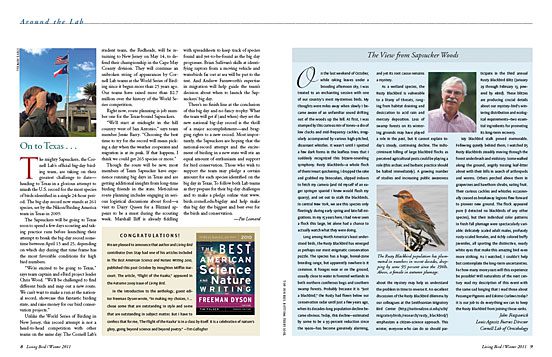View From Sapsucker Woods: Stopping the Decline of the Rusty Blackbird
By John Fitzpatrick
January 15, 2010
On the last weekend of October, while raking leaves under a brooding afternoon sky, I was treated to an enchanting session with one of our country’s most mysterious birds. My thoughts were miles away when slowly I became aware of an unfamiliar sound drifting out of the woods up the hill. At first, I was stumped by this curious mix of tones—a din of low clucks and mid-frequency cackles, irregularly accompanied by various high-pitched, dissonant whistles. It wasn’t until I spotted a few dark forms in the leafless trees that I suddenly recognized this bizarre-sounding symphony. Rusty Blackbirds—a whole flock of them! Heart quickening, I dropped the rake and grabbed my binoculars, slipped indoors to fetch my camera (and rid myself of an eager springer spaniel I knew would flush my quarry), and set out to stalk the blackbirds. In central New York, we see this species only fleetingly during early spring and late fall migrations. In my 15 years here, I had never seen a flock this large, let alone had a chance to actually watch what they were doing.
Long among North America’s least understood birds, the Rusty Blackbird has emerged as perhaps our most enigmatic conservation puzzle. The species has a huge, boreal-zone breeding range, but apparently nowhere is it common. It forages near or on the ground, usually close to water in forested wetlands in both northern coniferous bogs and southern swamp forests. Probably because it is “just a blackbird,” the Rusty had flown below our conservation radar until just a few years ago, when its decades-long population decline became obvious. Today, this decline—estimated by some to be a 95-percent reduction since the 1960s—has become genuinely alarming, and yet its root cause remains a mystery.
As a wetland species, the Rusty Blackbird is vulnerable to a litany of threats, ranging from habitat draining and desiccation to acid rain and mercury deposition. Loss of swamp forests on its wintering grounds may have played a role in the past, but it cannot explain today’s steady, continuing decline. The indiscriminant killing of large blackbird flocks as perceived agricultural pests could be playing a role (this archaic and barbaric practice should be halted immediately). A growing number of studies and increasing public awareness about the mystery may help us understand the problem in time to reverse it. An excellent discussion of the Rusty Blackbird dilemma by our colleagues at the Smithsonian Migratory Bird Center emphasizes a citizen-science approach. This winter, everyone who can do so should participate in the third annual Rusty Blackbird Blitz (January 29 through February 13, powered by eBird). These blitzes are producing crucial details about our mystery-bird’s wintering distribution and ecological requirements—two essential ingredients for promoting its long-term recovery.
My blackbird stalk proved memorable. Following quietly behind them, I watched 85 Rusty Blackbirds steadily moving through the forest underbrush and midstory. Some walked along the ground, angrily tossing leaf-litter about with their bills in search of arthropods and worms. Others perched above them in grapevines and hawthorn shrubs, eating fruit. Their curious cackles and whistles occasionally ceased as breakaway legions flew forward to pioneer new ground. The flock appeared pure (I detected no blackbirds of any other species), but their individual color patterns in fresh fall plumage were spectacularly variable: delicately scaled adult males, profusely rusty-scaled females, and richly colored buffy juveniles, all sporting the distinctive, nearly white eyes that make this amazing bird even more striking. As I watched, I couldn’t help but contemplate the long-term uncertainties. For how many more years will this experience be possible? Will naturalists of the next century read my description of this event with the same sad longing that I read those about Passenger Pigeons and Eskimo Curlews today? It is our job to do everything we can to keep the Rusty Blackbird from joining those ranks.

All About Birds
is a free resource
Available for everyone,
funded by donors like you
American Kestrel by Blair Dudeck / Macaulay Library



